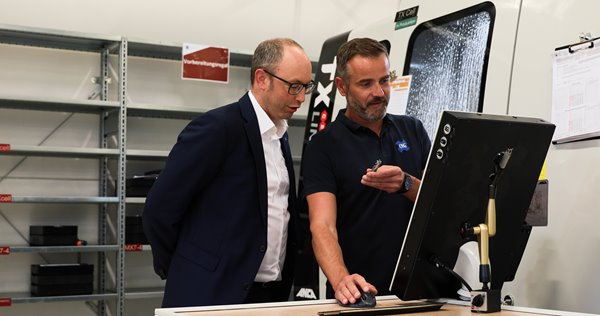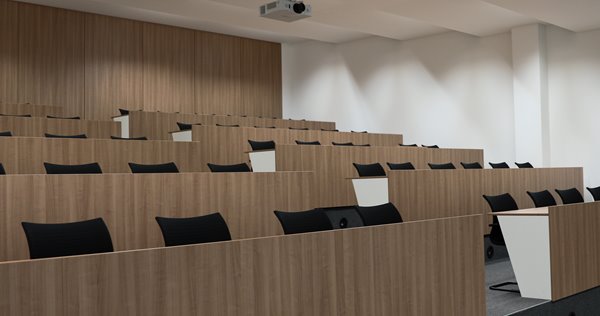E-Sharp News
March 2020
A global organisation like OSG Corporation hardly needs any introduction in the cutting tool industry, with its growth and experience spanning over 80 years since its foundation in 1938 and a production, sales and technology network in 33 countries. The company operates in the industrial environment, producing shaft tools for the entire industrial market with the automotive sector serving as their main customers, although they are seeing an increased demand from other industries including medical, dental, and IT.
Based in the southern town of Göppingen, OSG’s German manufacturing facility is over 5000 m2 and is also home to the OSG Academy, a technology centre for demonstrations including research and development for the German and European market.
Oliver Schunter, Head of Finance and Admin at OSG GmbH said: “Our main motivation in the German market is to support the local industry with our tools, which we produce in Germany. We want to run production 24 hours a day, seven days a week and implement this in single shift operations.”
Erhard Baltes, Production Manager at OSG GmbH said: “A big advantage that our customers get with our tools is a stable, consistent quality. Due to the many specific processes that we perform, the high number of measurements that we carry out, and the many tests that we conduct continuously, they almost always get the same quality tool.”
“To achieve our goal of increasing our production, we have improved and adapted a number of things. We have introduced consistently stable room temperature, very high grinding oil quality, very good air quality; this is often neglected. We have also focussed on program optimisation, correct selection of carbide types, and suitable grinding wheels for the respective carbide grade, and so it is a constant process to improve ourselves.”
“The ANCA software offers us many options when designing our tools. In the past few months, even years, we have tested various well-known market competitors of ANCA. We can play the ‘ANCA piano’ very well, so to speak.”

Oliver Schunter (left) and Erhard Baltes (right) in front of an ANCA TXcell Linear
Investing in employees and technology a key to success and sustainability
Oliver Schunter said: “We have taken the next step with the OSG Academy to offer additional services to customers. Workshops are held, training programs are facilitated, tests are conducted for customers in order to validate and use the tools they have produced and to then modify them.”
“Of course, the OSG Academy is not only used for our customers, but also importantly, for the further education and training of our own employees, so that they understand which products we manufacture, how they are used and what impact small differences in the product can have for an application.”
“The fact that the employees face challenges and receive constant training and educate themselves means that our people have a chance to prove themselves every day – and in doing so, also increase their own value and thereby advance their careers,” Oliver concluded.

Erhard Baltes said: “Thanks to the optimisations we have made roughly two years ago, we have been able to increase our production by 33%. The goal is to increase this by another 25%.”
“We are constantly improving our processes and we cannot avoid making new investments. That means, in new machines, in new technologies, in training our employees – which of course are also costs for us. These are essential to survive in the market.”
“We invest in new ANCA machines, or machines in general; as we need the latest technology in order to constantly improve or maintain our quality. Due to the long running times of our machines, in some cases seven days a week, sometimes 24 hours, we simply have to compensate for this wear and tear. We are talking about machines that have a life span of around 10 years.”
“We currently have eight MX7s in Germany – five of which are linear machines, three of which still have the ballscrew. We don't notice a big difference in quality. The surfaces are also identical. We have two TX7+, a TX7 Linear, a TXcell, and two RX7s. That is a total of 16 ANCA grinding machines.”
“We use many robots to load the blanks into the grinding machines. It’s a process that goes on all night. Loading, unloading, grinding, digitising – all in the one process. The aim is to let the machine run from shortly before the end of the work day, at 4pm until the next morning at 7am when the next shift starts again.”
“I believe that the iView measuring system is a crucial tool on our ANCA machines, because it allows us to produce and reproduce our sometimes very complex contours with micron precision. This means that contours with a deviation of 5 microns can be generated, measured, and checked in the machine, in the tool clamping fixture. We don't have to set up anything or use an external measuring machine, giving us much more flexibility. That means the measuring points can be entirely generated in this way.”
The pursuit of quality through continuous improvement
Oliver Schunter said: “Our European boss Hideaki Osawa always emphasises that we should fulfil the following mission:
Contribution to better manufacturing in your country. That means we try to get involved in the locally specific production and to improve them. Our goal is always constant improvement.”
Erhard Baltes agrees with Oliver, adding that “the most important reason why we do as much as possible here is the quality. We produce as much as possible in-house because customers expect highest quality, and the more we can do internally the better it is for the product.”
13 March 2020